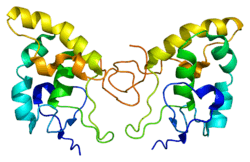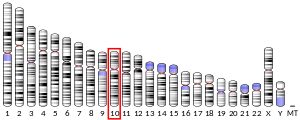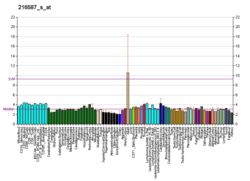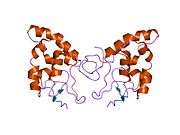FZD8
Frizzled-8 is a protein that in humans is encoded by the FZD8 gene.[4][5]
Function
This intronless gene is a member of the frizzled gene family. Members of this family encode seven-transmembrane domain proteins that are receptors for the Wingless type MMTV integration site family of signaling proteins. Most frizzled receptors are coupled to the beta-catenin canonical signaling pathway. This gene is highly expressed in two human cancer cell lines, indicating that it may play a role in several types of cancer. The crystal structure of the extracellular cysteine-rich domain of a similar mouse protein has been determined.[5]
gollark: I can only do this apparently.
gollark: I'm not, I logged out.
gollark: Little did /dev/wd0c know that I hackerized R. Danny.
gollark: <@!309787486278909952> emuwar wiki admin pl0x
gollark: This is all part of my evil campaign™ to become admin, but baidicoot apparently cannot do that.
See also
References
- GRCh38: Ensembl release 89: ENSG00000177283 - Ensembl, May 2017
- "Human PubMed Reference:". National Center for Biotechnology Information, U.S. National Library of Medicine.
- "Mouse PubMed Reference:". National Center for Biotechnology Information, U.S. National Library of Medicine.
- Saitoh T, Hirai M, Katoh M (Apr 2001). "Molecular cloning and characterization of human Frizzled-8 gene on chromosome 10p11.2". Int J Oncol. 18 (5): 991–6. doi:10.3892/ijo.18.5.991. PMID 11295046.
- "Entrez Gene: FZD8 frizzled homolog 8 (Drosophila)".
Further reading
- Wang Y, Macke JP, Abella BS, Andreasson K, Worley P, Gilbert DJ, Copeland NG, Jenkins NA, Nathans J (1996). "A large family of putative transmembrane receptors homologous to the product of the Drosophila tissue polarity gene frizzled". J. Biol. Chem. 271 (8): 4468–4476. doi:10.1074/jbc.271.8.4468. PMID 8626800.
- Finch PW, He X, Kelley MJ, Uren A, Schaudies RP, Popescu NC, Rudikoff S, Aaronson SA, Varmus HE, Rubin JS (1997). "Purification and molecular cloning of a secreted, Frizzled-related antagonist of Wnt action". Proc. Natl. Acad. Sci. U.S.A. 94 (13): 6770–6775. doi:10.1073/pnas.94.13.6770. PMC 21233. PMID 9192640.
- Tamai K, Semenov M, Kato Y, Spokony R, Liu C, Katsuyama Y, Hess F, Saint-Jeannet JP, He X (2000). "LDL-receptor-related proteins in Wnt signal transduction". Nature. 407 (6803): 530–535. doi:10.1038/35035117. PMID 11029007.
- Hartley JL, Temple GF, Brasch MA (2001). "DNA cloning using in vitro site-specific recombination". Genome Res. 10 (11): 1788–1795. doi:10.1101/gr.143000. PMC 310948. PMID 11076863.
- Semënov MV, Tamai K, Brott BK, Kühl M, Sokol S, He X (2001). "Head inducer Dickkopf-1 is a ligand for Wnt coreceptor LRP6". Curr. Biol. 11 (12): 951–961. doi:10.1016/S0960-9822(01)00290-1. PMID 11448771.
- Dann CE, Hsieh JC, Rattner A, Sharma D, Nathans J, Leahy DJ (2001). "Insights into Wnt binding and signalling from the structures of two Frizzled cysteine-rich domains". Nature. 412 (6842): 86–90. doi:10.1038/35083601. PMID 11452312.
- Yao R, Maeda T, Takada S, Noda T (2001). "Identification of a PDZ domain containing Golgi protein, GOPC, as an interaction partner of frizzled". Biochem. Biophys. Res. Commun. 286 (4): 771–778. doi:10.1006/bbrc.2001.5430. PMID 11520064.
- Omoto S, Hayashi T, Kitahara K, Takeuchi T, Ueoka Y (2004). "Autosomal dominant familial exudative vitreoretinopathy in two Japanese families with FZD4 mutations (H69Y and C181R)". Ophthalmic Genet. 25 (2): 81–90. doi:10.1080/13816810490514270. PMID 15370539.
- Lu W, Yamamoto V, Ortega B, Baltimore D (2004). "Mammalian Ryk is a Wnt coreceptor required for stimulation of neurite outgrowth". Cell. 119 (1): 97–108. doi:10.1016/j.cell.2004.09.019. PMID 15454084.
External links
- "Frizzled Receptors: FZD8". IUPHAR Database of Receptors and Ion Channels. International Union of Basic and Clinical Pharmacology.
- Overview of all the structural information available in the PDB for UniProt: Q9H461 (Human Frizzled-8 (FZD8)) at the PDBe-KB.
This article incorporates text from the United States National Library of Medicine, which is in the public domain.
This article is issued from Wikipedia. The text is licensed under Creative Commons - Attribution - Sharealike. Additional terms may apply for the media files.




